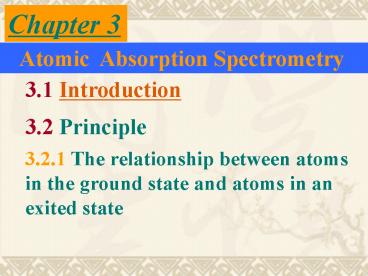Atomic Absorption Spectrometry PowerPoint PPT Presentation
1 / 32
Title: Atomic Absorption Spectrometry
1
Chapter 3
Atomic Absorption Spectrometry
3.1 Introduction
3.2 Principle
3.2.1 The relationship between atoms in the
ground state and atoms in an exited state
2
? Atomic Absorption Spectrometry e.g.
? Boltzmans equation
3.2.2 The relationship between Atomic Absorption
and Atomic concentration
? Calculus measurement
? Volvss peak value absorption theory Fig3.2-1
3.3 Instruments
3
3.3.1 Primary radiation sources
? The hollow-cathode lamp(HCL) Fig3.3-1
? Other radiation sources
3.3.2 Source of free atoms
? The flame atomizer
?. Constitution and working principle Fig 3.3-2
?. The flame Fig3.3-3
? The electro-thermal atomizer Fig3.3-4
4
3.3.3 Optical diapersive systems Fig3.3-5
Fig3.3-6
3.3.4 Detectors
3.4 Interferences and its elimination method
3.5 Quantitative analytic method
3.5.1 Standard curve method
3.5.2 Standard additon method Fig3.5-1
5
3.6 The sensitivity (S) and detection limit of
AAS analysis
? Sensitivity (S)
6
? Detection limit (D)
7
In contrast to atomic emission spectrometry
(AES), atomic absorption spectrometry (AAS) in
terms of analytical method is a recent technique,
having been described by Walsh in 1955.
8
The first atomic absorption observations were
of the Fraunhofer lines in the solar spectrum and
were made in 1802 by Wollaston.
9
Optical transitions used for AAS are between
the ground state, or near the ground state, and
the first excited levels (resonance levels).
10
The population of the various levels is
described by the Boltzmann law.
11
Since the absorption of the radiation is
proportional to the number of atoms in the ground
state, this explains why AAS is an efficient
method.
12
In the case of Al, the most commonly-used
lines are Al I 309.28, Al I 308.22 nm, i.e., a
transition between the 3p and 3d subshells
13
and Al I 396.15 nm and Al I 394.40 nm, i.e., a
transition between the 3p and 4s subshells.
Fig.3.2
14
Boltzmans equation
15
Lamberts law
The relationship between line integrated
absorption and the number of atoms in the ground
state
16
Peak absorption coefficient is
In practical analytical work, lamberts law is
A K'LC
17
The whole process is
18
Characteristics
? Little working current
? Low pressure sealing
19
e.g.
? Electrodeless discharge lamp ( EDL)
? Electrion HCl
? The diode lasers
? The continuum source
20
The use of organic solvents increases not only
the efficiency of nebulization but also the
temperature of the flame.
21
An alternative to the injection of wet
aerosols with flame-AAS is the introduction of
volatile species.
22
Hydride generation is the most commonly-used
system elements such as As, Bi, Ge, Pb, Sb, Se,
and Sn.
23
Hydrides are usually obtained by s\adding
sodium borohydride to acidified solutions.
24
This atomizer makes use of an electrically
heated refractory material on which the sample is
deposited.
25
A transient formation of free atoms is then
obtained.
26
Both single- and double-beam systems are
used. Since beam splitting is performed with a
double-beam system,
27
the signal to noise ratio is degraded compared
with a single-beam system.
28
Monochromators make use of the
photomultiplier tube whereas the
echellegrating-based polychromator utilizes a new
solid-state detector
29
which incorporates a set of photodiodes. About 60
photodiodes are used for both primary and
secondary lines of the most important elements.
30
Chemical interference
Elimination
? Add a buffer
? Use a hotter flame such as the N2O-acetylene
flame
? Add chemical modifiers
31
Spectral interference
Elimination
? Change HCL
? Decrease slit and light current
32
Background subtraction
Elimination
? The deuterium lamp method
? The Zeeman effect method
? The Smith-Hieftje method

